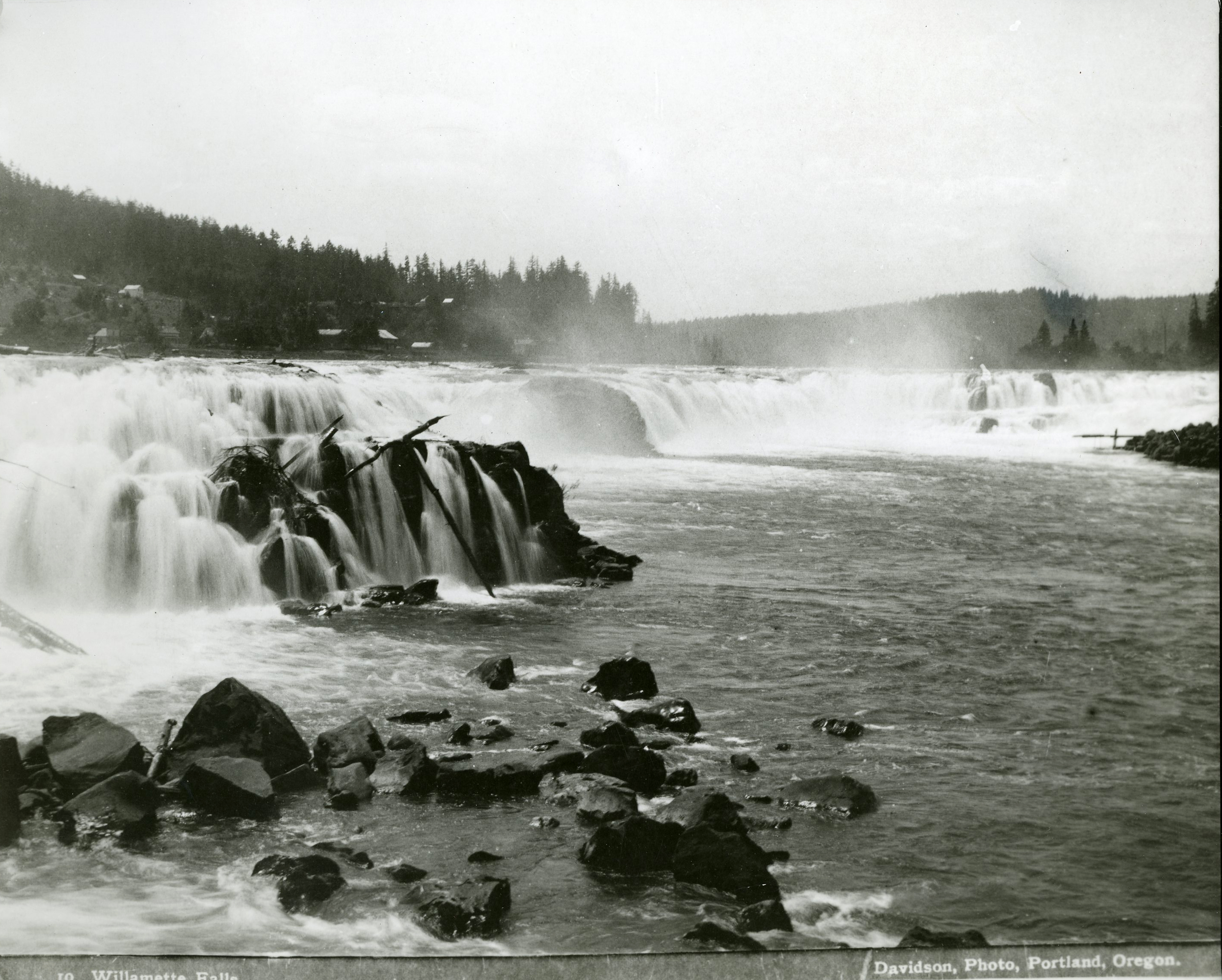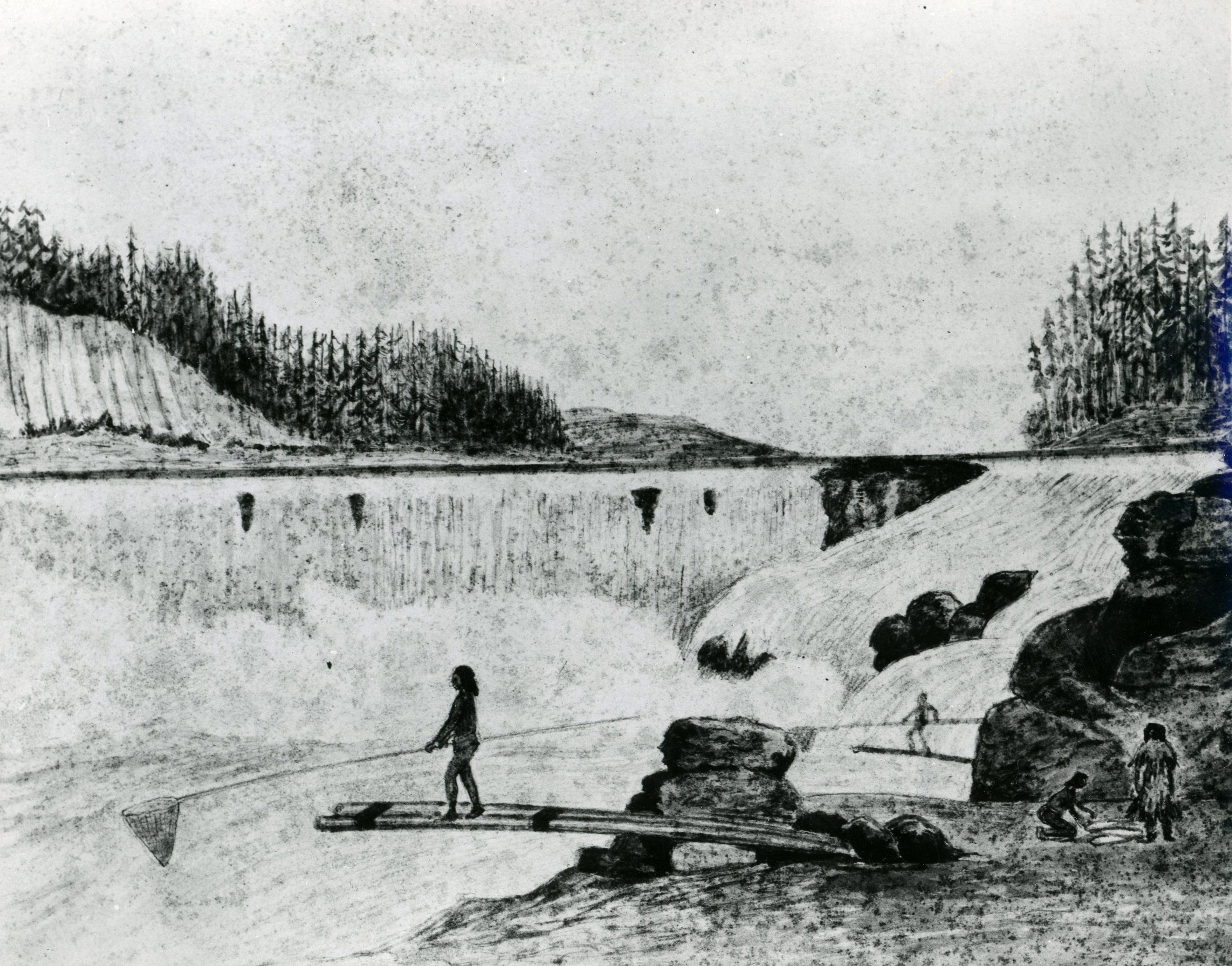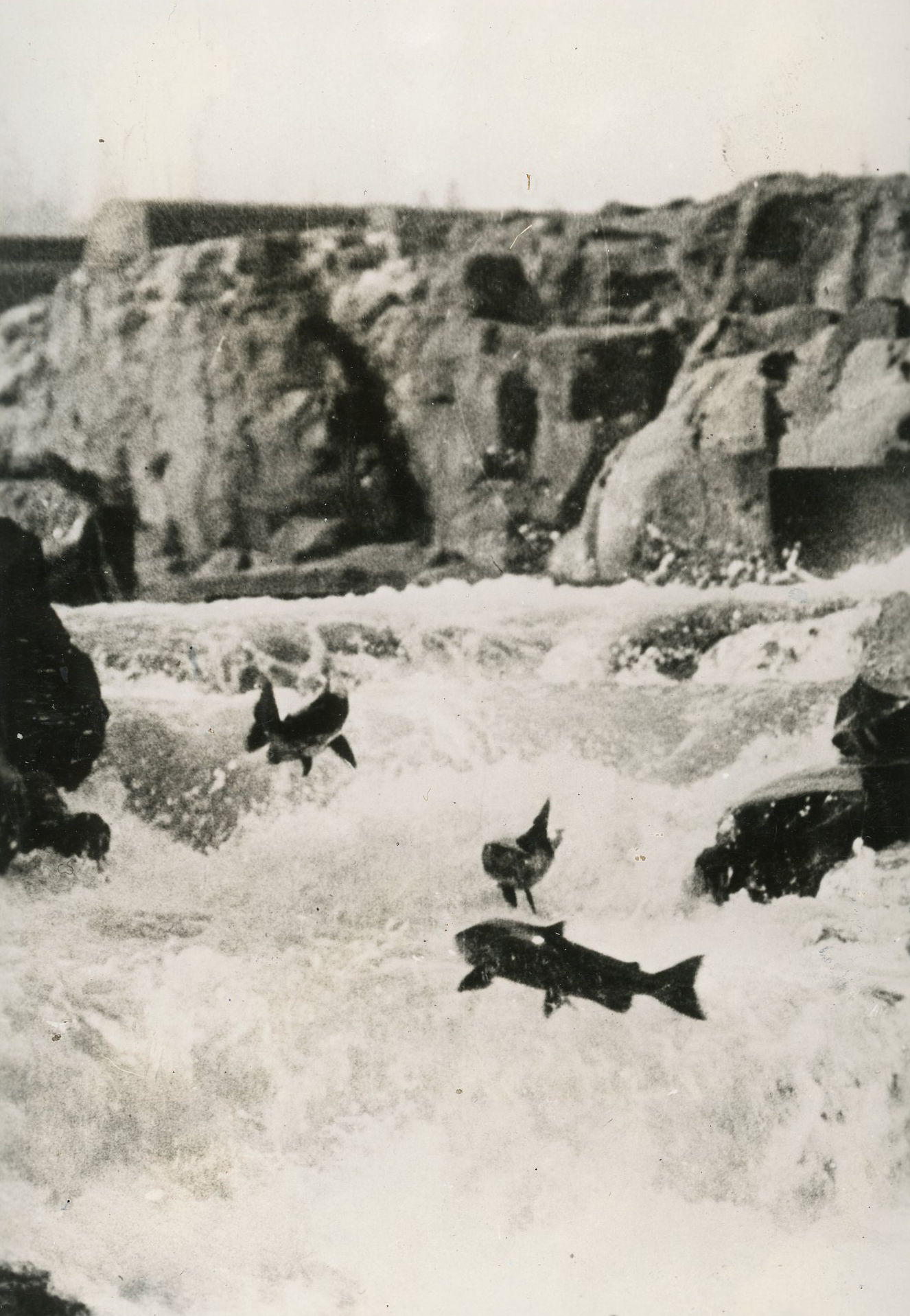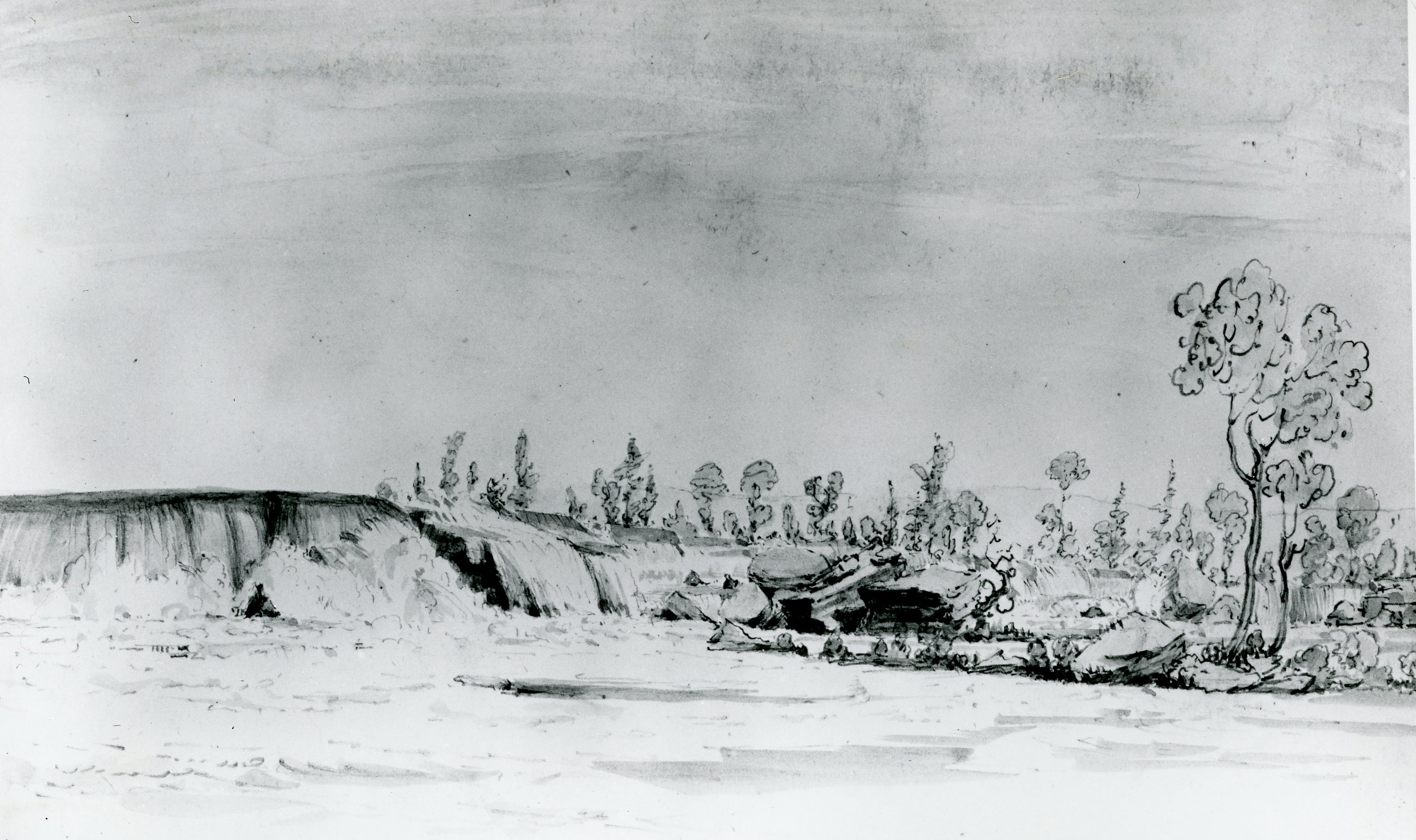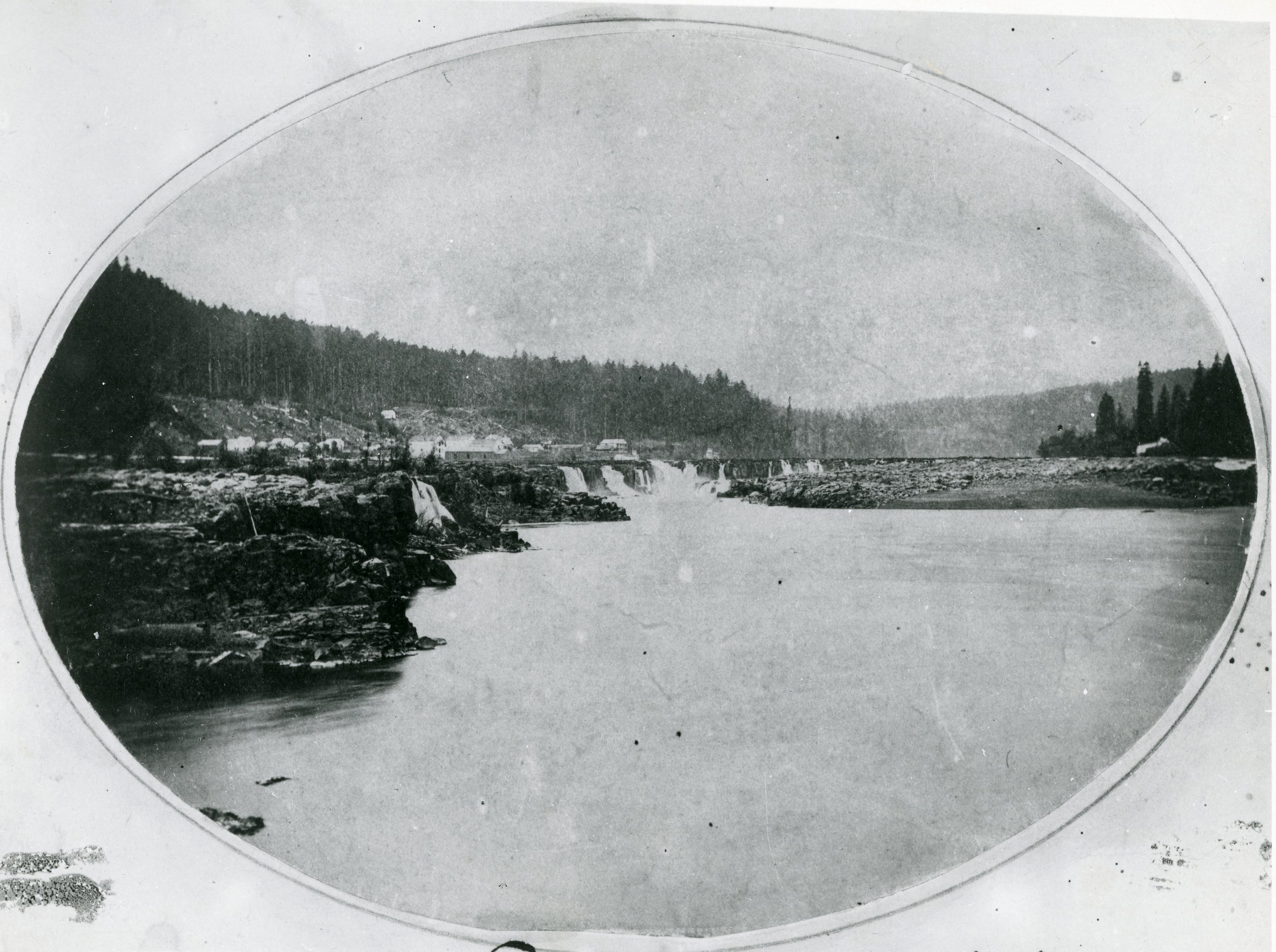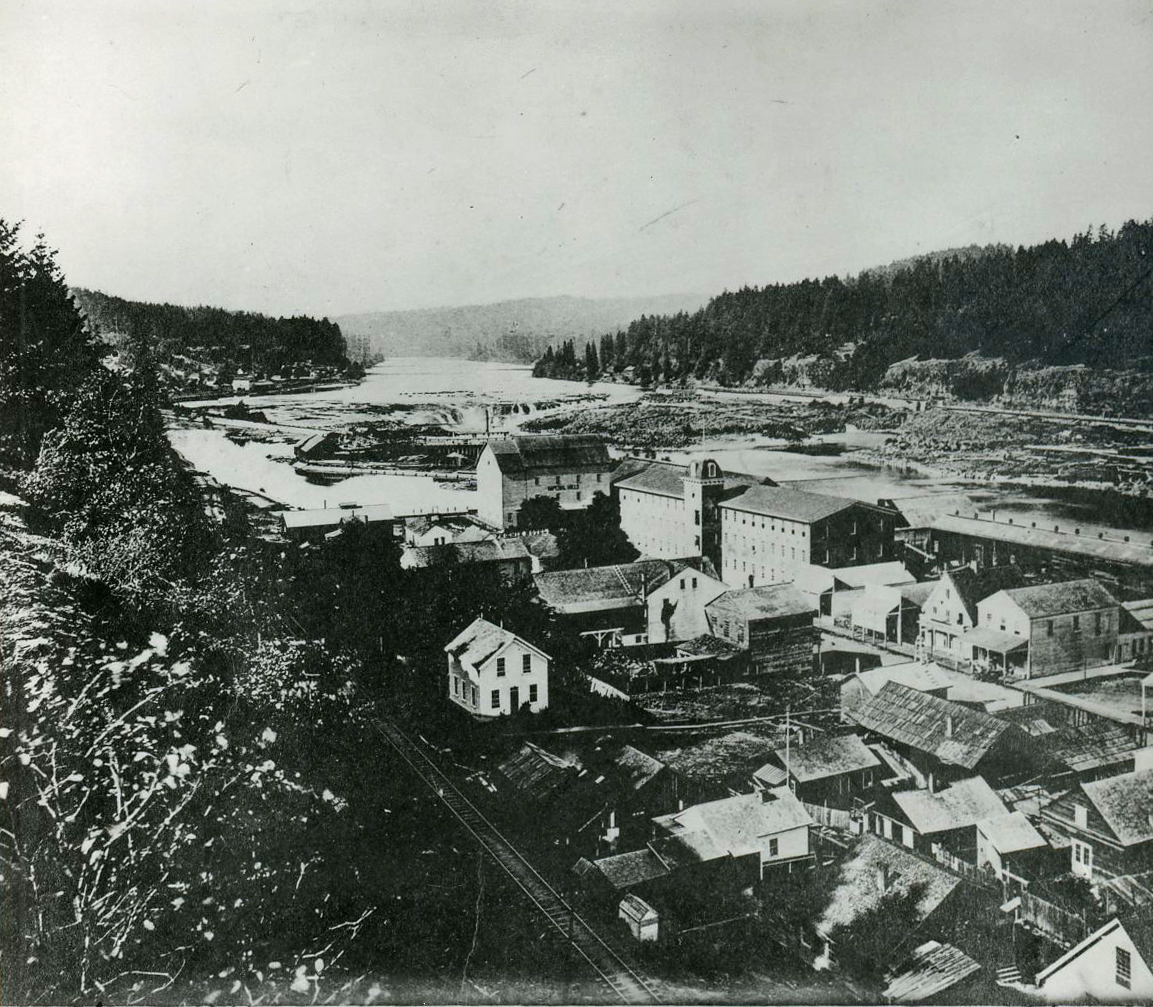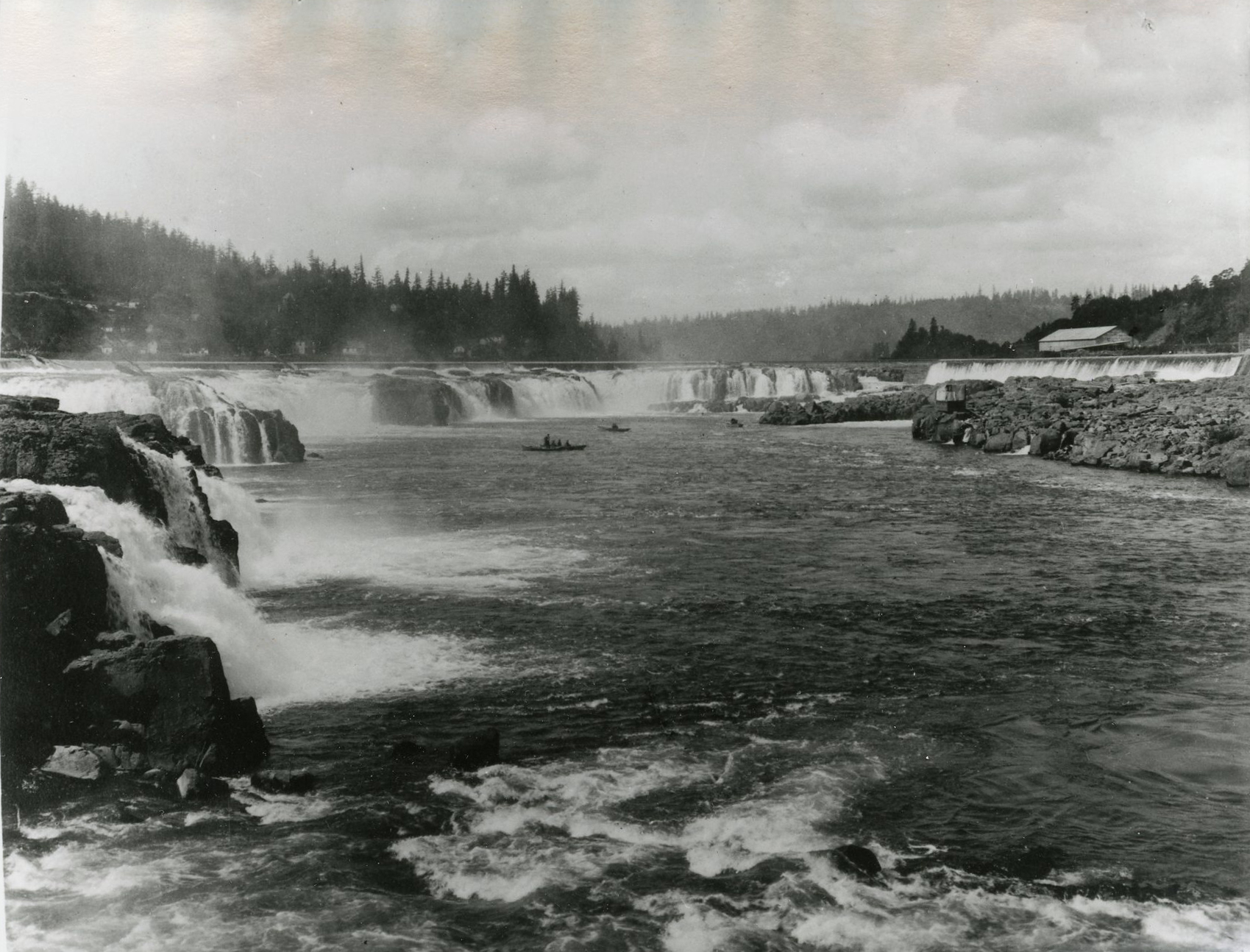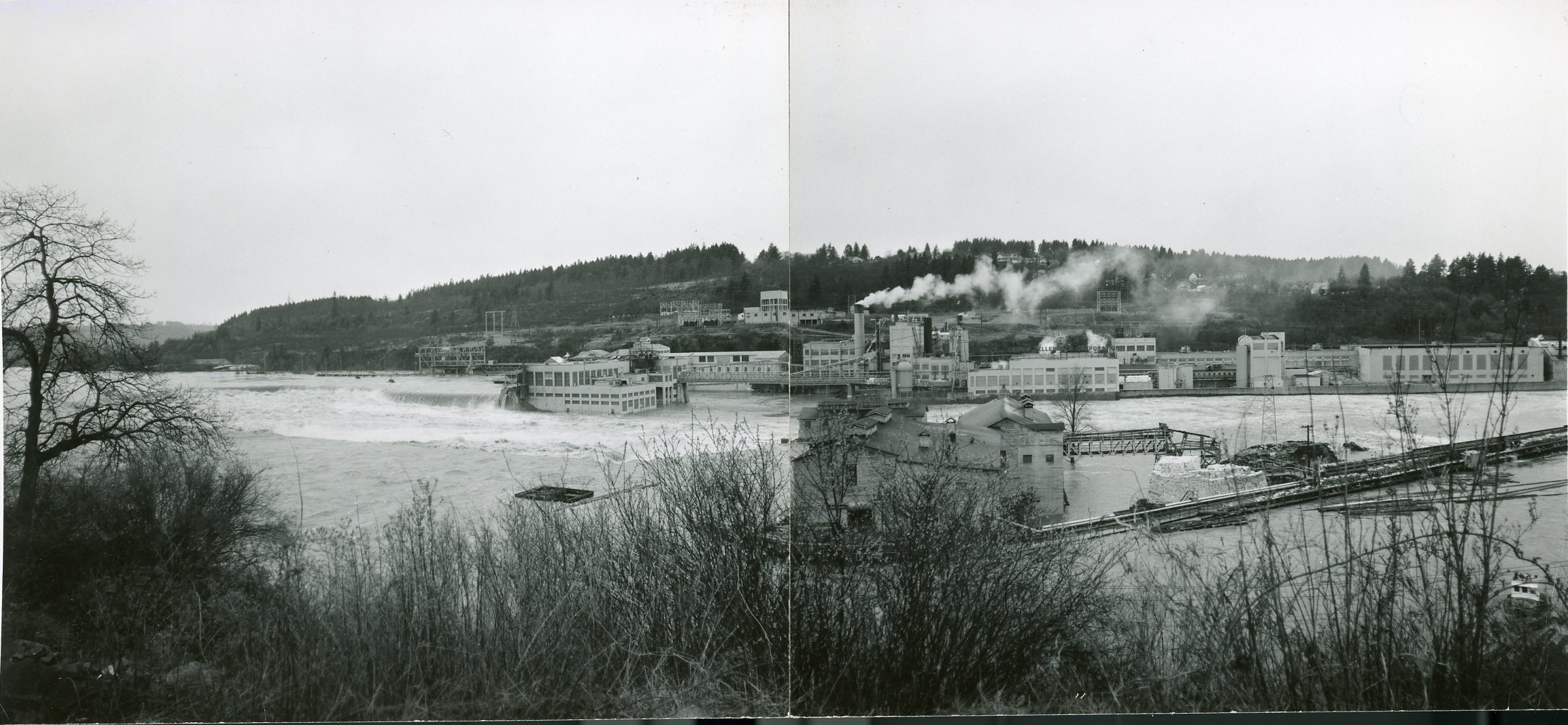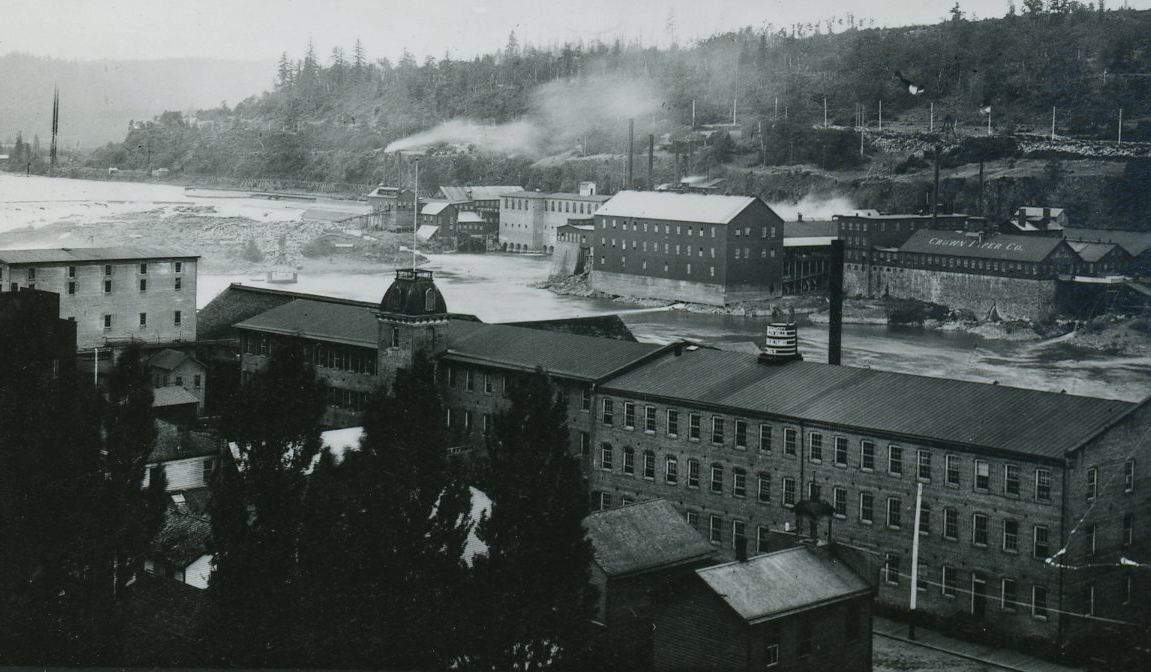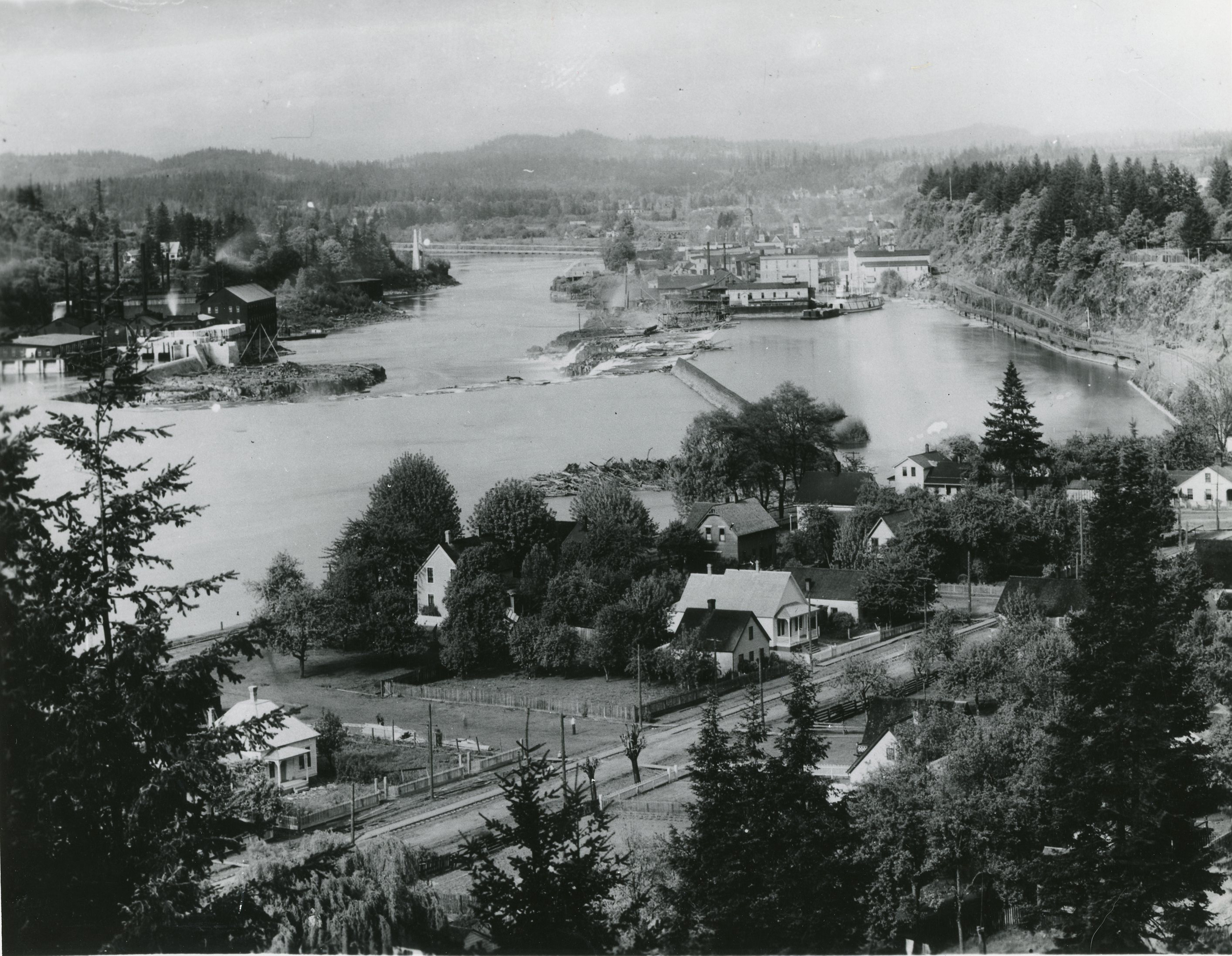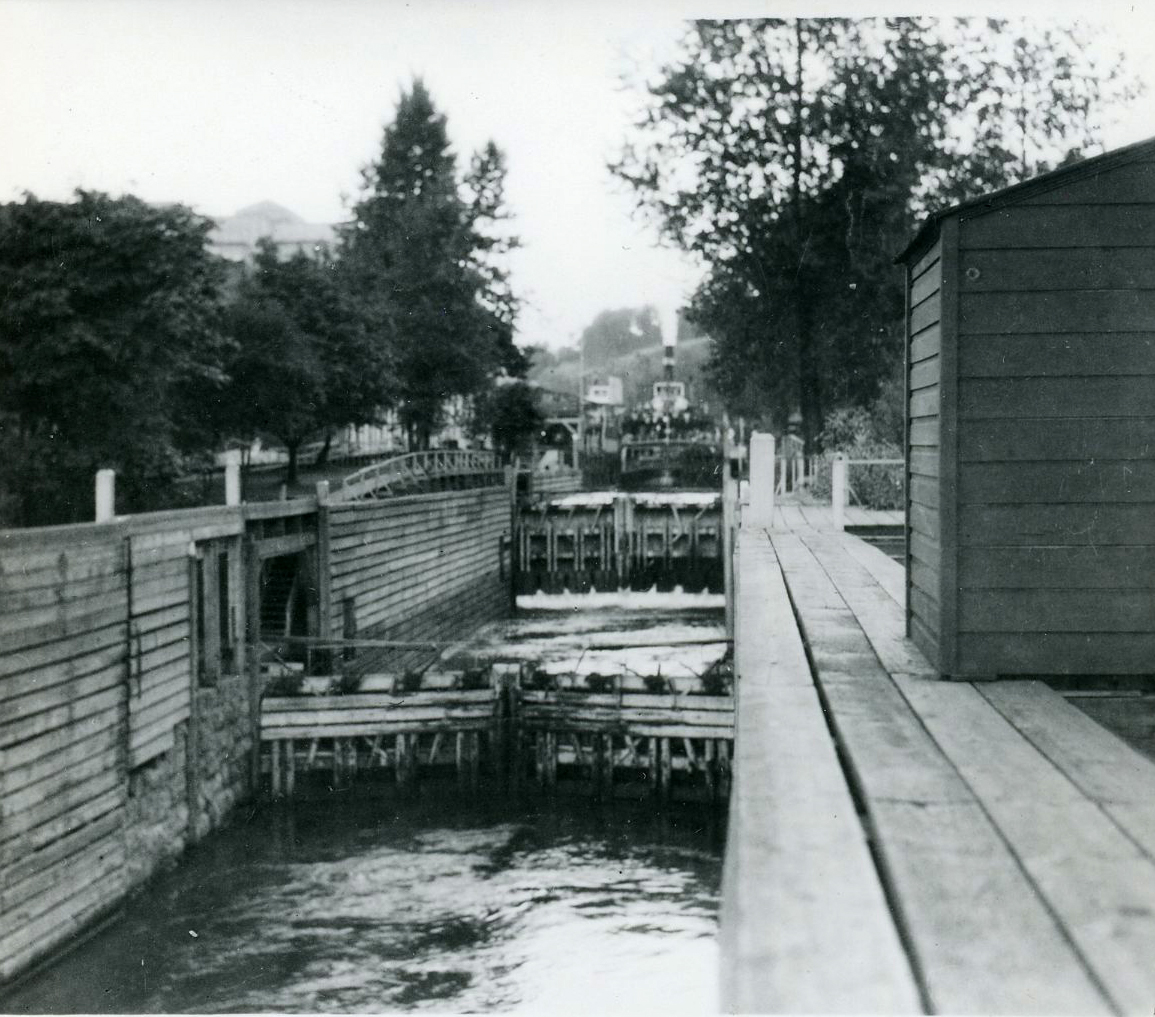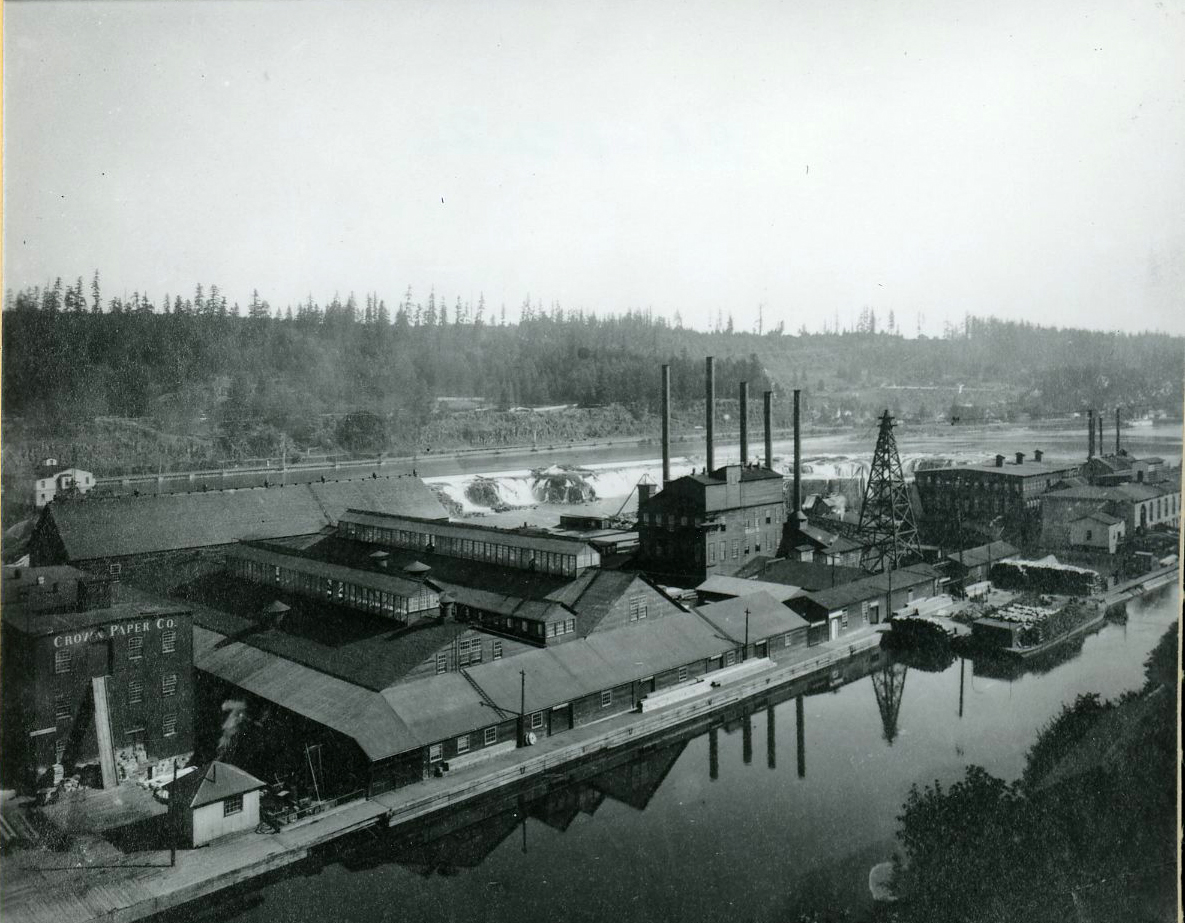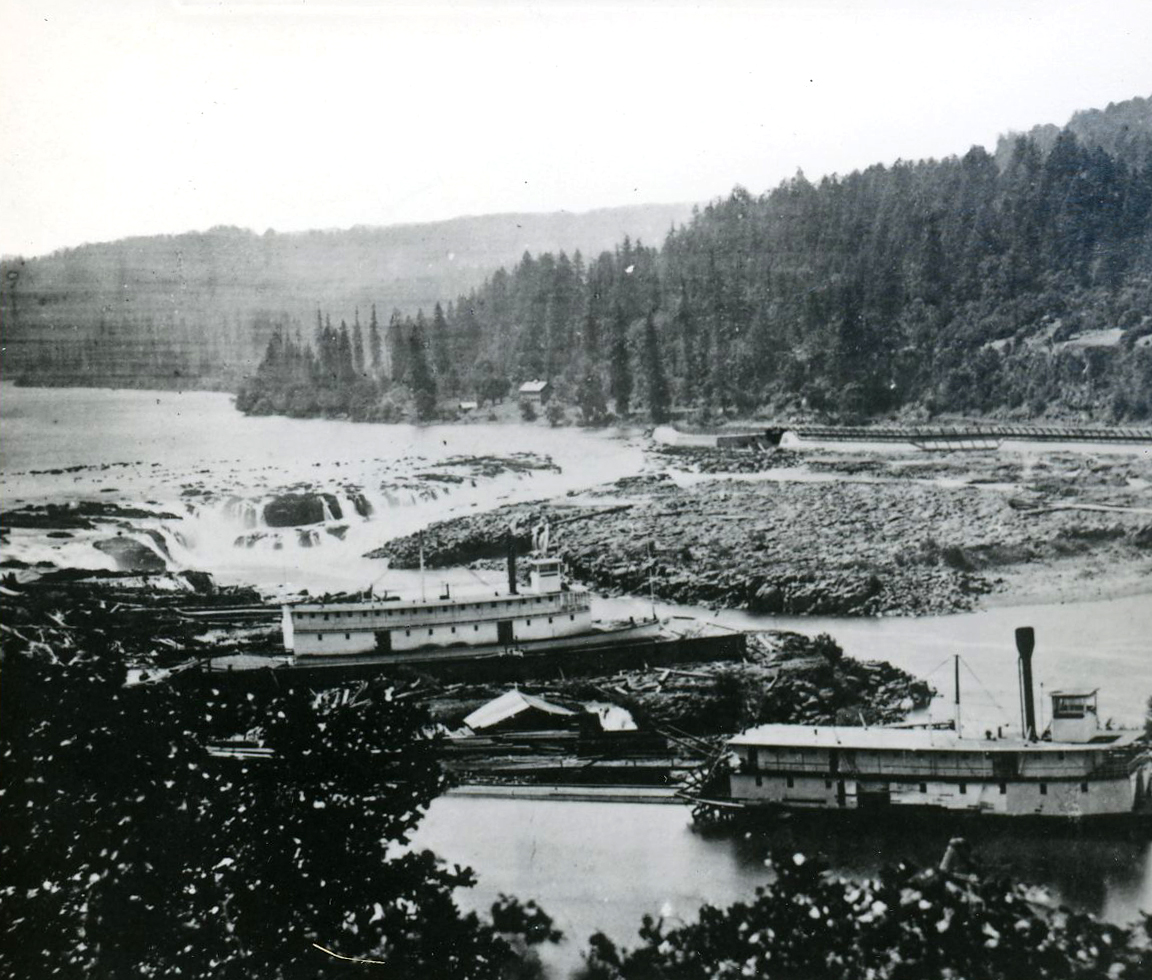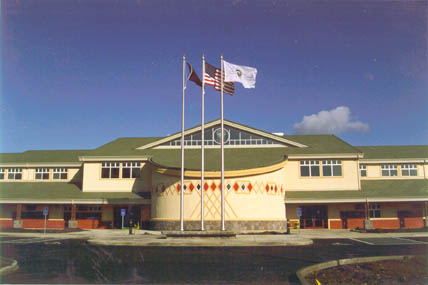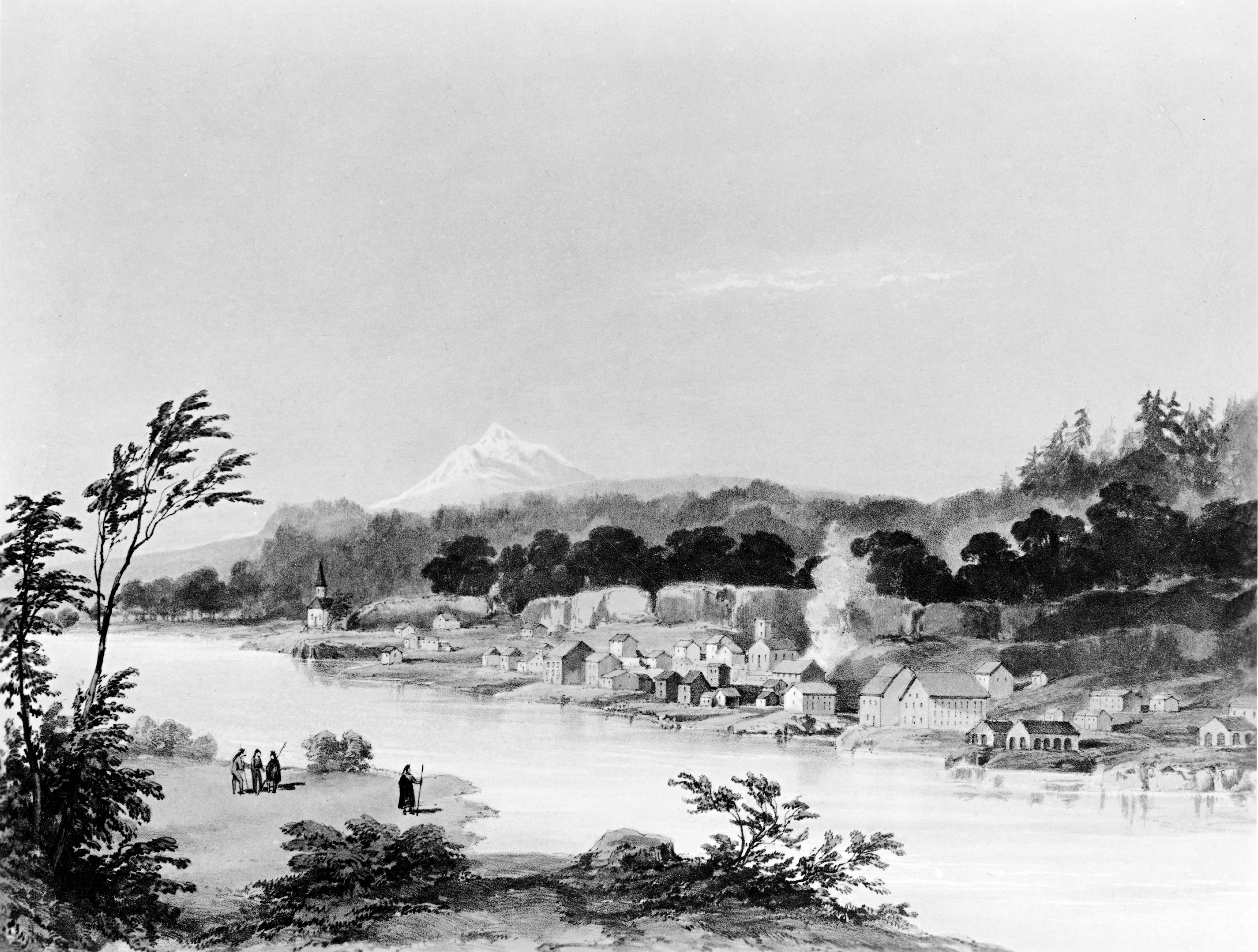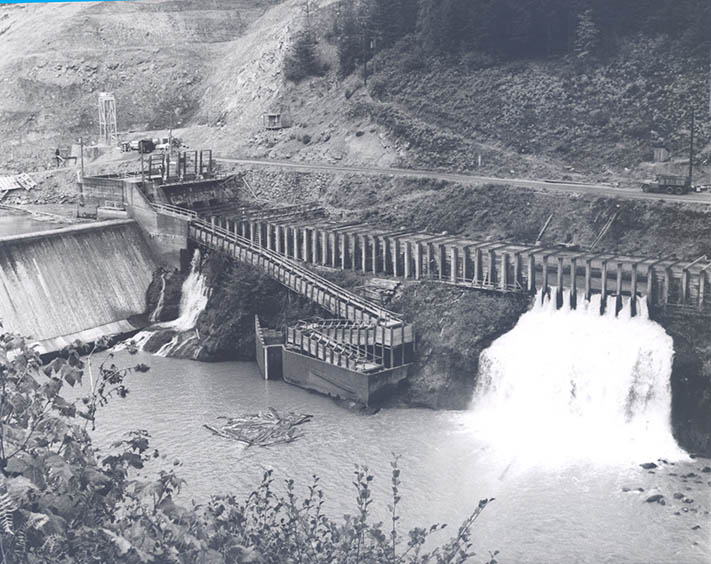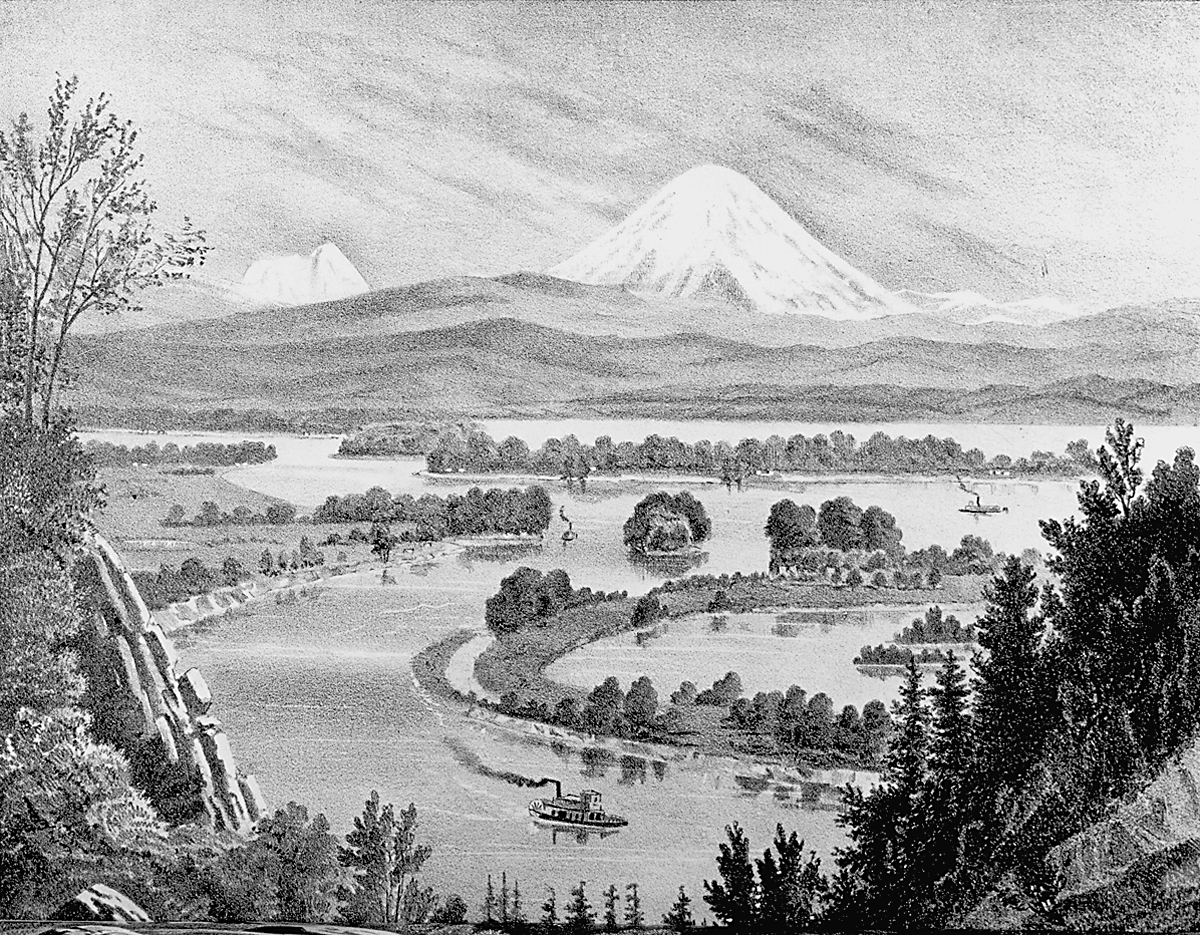The largest falls in Oregon and the sixth in the United States by volume, Willamette Falls is one of the most significant natural features in the state. A Native salmon and lamprey fishery for at least eight thousand years, Willamette Falls drops thirty-five feet from the Willamette Valley into the Oregon City–West Linn basin. Beginning in the mid-nineteenth century, the falls powered the earliest mills in the region and contributed to the growth of the first United States government in the Oregon Territory.
The Clackamas Chinook peoples, including the Clowewalla, occupied villages and houses on the east and west banks of the Willamette River, as well as above the falls at Canemah, on the east bank of the river just south of present-day downtown Oregon City. The village on the other side of the river from the Clackamas River estuary was named Walamt, the origin of the name Willamette. The falls were fished by the Clackamas people, who controlled access to the valuable salmon, steelhead, and lamprey at the falls. Other tribes—Wasco, Multnomah, Yakama, Tualatin, and Molala—visited the Clackamas village at the falls to trade for nutritious air-dried salmon and to request fishing rights.
During the nineteenth century, white explorers and fur traders recorded the existence of Willamette Falls. In 1806, William Clark collected a narrative about the falls from a Clowewalla he encountered downriver, and other descriptions appeared in the journals and reports of British botanist and explorer David Douglas, pioneer Jesse Applegate, Canadian artist Paul Kane, and U.S. diplomat William Slacum. Indians helped traders and other non-Natives portage the falls, often hosting the travelers, feeding them, and hiring on as guides, scouts, and oarsmen.
Chief Factor John McLoughlin of the Hudson’s Bay Company established the first non-Native settlement at Willamette Falls in 1829, and he built a sawmill there. After 1846, when the Oregon Treaty was signed, Americans constructed sawmills and fabric mills on both banks of the river at the falls. At Oregon City, on the east bank of the Willamette, settlers put in place the first United States government in the West. The town of Willamette Falls was established to the south, and Linn City (present-day West Linn) was across the river. The newcomers worked the fishery at the falls, constructing at least one fish wheel (Brown Brothers in 1896) at the base to capture salmon before the fish jumped the falls.
The last Native longhouse at Willamette Falls, built by the Clackamas Clowewalla, was deliberately burned by unknown persons in 1848. By then, the Clackamas had lost 90 percent of their population from introduced malarial epidemics, which began in 1829 and lasted into the 1840s. The federal government removed the remainder of the Clackamas people, some two dozen individuals, to the Grand Ronde Reservation in 1856. Chief Wacheno was the last Clackamas chief to live at the falls before removal to Grand Ronde. Many Clackamas returned at least once each year to Willamette Falls to fish for salmon and lamprey, and they maintained a fishing camp on the west bank into the 1870s.
Farmers and ranchers shipped wheat, vegetables, timber, sheep fleeces, and other products downriver on schooners and barges to Canemah, the closest town above the falls on the east bank, and then portaged the loads around the falls. In 1841, William Slacum had the first American lumber mill built at Willamette Falls in order to establish an American presence there, but the mill never operated. Willamette Falls Woolen Mill was opened in 1857, and Oregon City Woolen Mill began operations in 1862. In 1873, the Oregon City Locks were opened through the west side of the falls, enabling schooners and steamboats to pass from the upper to the lower river.
Beginning in the 1860s, paper mills began operations using the water power from the falls. Oregon City Paper Manufacturing Co. began operations in 1866, and the Willamette Pulp and Paper Co. began on the West Linn side in 1889. The two remaining mills in 2011 were owned by the West Linn Paper Company and Blue Heron, which ceased operations in 2013.
Electricity was generated at Willamette Falls in 1888, when Parker F. Morey and Edward L. Eastham created the Willamette Falls Electric Company. In the 1890s, the falls was the site of the first successful plant in the United States to send electricity through long-distance power lines—direct current in 1889 and alternating current in 1890. Willamette Falls provided electricity for the Pacific Gas & Electric Company at its plant on the west bank, near sawmills and paper plants. In 1892, Morey, Frederick Van Voorhies Holman, and Henry Failing formed the Portland General Electric Company, which continues to generate electricity at the falls today.
The Oregon City Locks were closed in in 2008, reopened in 2009, and again closed in 2011 due to lack of funding for inspection and repairs by the Army Corps of Engineers. The locks are no longer essential for river commerce, as rail and trucks now move most products in the Willamette Valley, and their maintenance is not a priority for the federal government.
Grand Ronde, Yakima, Cowlitz and Warm Springs people still visit the falls to fish for salmon and to study the last healthy lamprey run in the Columbia River watershed. It is also a destination for sport fishermen, both above and below the falls, and for jet-boat heritage tours. Local festivals at the falls include the Willamette Falls Celebration and Lockfest. The City of Oregon City is working on a plan to develop a riverside access path to the falls, and the property of the former Blue Heron site is slated for a mixed-use heritage tourism and business park. In 2015, Willamette Falls and the communities of Oregon City, West Linn, and Lake Oswego were designated a State Heritage Area by the Oregon Heritage Commission.
-
![]()
Willamette Falls, 1878.
Courtesy Oreg. Hist. Soc. Research Library, 612
-
![]()
Sketch of Willamette Falls and Native fishers, by Joseph Drayton of the Wilkes Expedition, c. 1841.
Courtesy Oreg. Hist. Soc. Research Library, 968
-
![]()
Salmon migrating up Willamette Falls.
Photo by Ralph Eddy. Courtesy Oreg. Hist. Soc. Research Library, 53943
-
![]()
Willamette Falls, sketch by Paul Kane in about 1846.
Courtesy Oreg. Hist. Soc. Research Library, 65600
-
![]()
Willamette Falls and Canemah (left), c. 1864.
Courtesy Oreg. Hist. Soc. Research Library, 38416
-
![]()
Woolen Mills, with tower, at Oregon City, 1872.
Courtesy Oreg. Hist. Soc. Research Library, 010586
-
![]()
Willamette Falls.
Courtesy Oreg. Hist. Soc. Research Library, OrHi96754
-
![]()
Oregon City and Willamette Falls.
Courtesy Oregon Hist. Soc. Research Lib., ba018369
-
![]()
Early electric power facility on Willamette Falls, c. 1890.
Courtesy Oreg. Hist. Soc. Research Library, 006684
-
![]()
Woolen Mills, Crown Paper, and an early powerhouse in about 1895.
Courtesy Oreg. Hist. Soc. Research Library, 005567
-
![]()
Willamette Falls and Canemah, c. 1900.
Courtesy Oreg. Hist. Soc. Research Library, 23628
-
![]()
Portland Railway, Light, and Power, Station B, 1911.
Courtesy Oreg. Hist. Soc. Research Library, 003646
-
![]()
The "Beaver" passing through the locks.
Courtesy Oreg. Hist. Soc. Research Library, 003149
-
![]()
An aerial view of Willamette Falls, with West Linn on the left and Oregon City on the right. The mill belonged to Crown Zellerbach..
Courtesy Oreg. Hist. Soc. Research Library, 66102
-
![]()
Willamette Pulp and Power and Crown Paper.
Courtesy Oreg. Hist. Soc. Research Library, 005755
-
![]()
Sternwheelers navigating the falls and locks.
Courtesy Oreg. Hist. Soc. Research Library, 004615
-
![]()
Willamette Falls.
Courtesy Oreg. Hist. Soc. Research Library, ba014414
Related Entries
-
![Canemah]()
Canemah
Canemah, once the bustling terminus of navigation on the upper Willamet…
-
![Confederated Tribes of Grand Ronde]()
Confederated Tribes of Grand Ronde
The Confederated Tribes of Grand Ronde Community of Oregon is a confede…
-
![John McLoughlin (1784-1857)]()
John McLoughlin (1784-1857)
One of the most powerful and polarizing people in Oregon history, John …
-
![Molalla Peoples]()
Molalla Peoples
The name Molalla ([moˈlɑlə, ˈmolɑlə], usually spelled Molala by anthrop…
-
![Oregon City]()
Oregon City
Oregon City was the first incorporated city west of the Rocky Mountains…
-
![Portland Railway Light and Power]()
Portland Railway Light and Power
Portland Railway Light & Power (PRLP) was created in 1906 through the c…
-
![Salmon]()
Salmon
The word “salmon” originally referred to Atlantic salmon (Salmo salar),…
-
![Tualatin peoples]()
Tualatin peoples
Tualatin (properly pronounced 'twälə.tun in English) was the name of a …
-
Willamette River
The Willamette River and its extensive drainage basin lie in the greate…
Related Historical Records
Map This on the Oregon History WayFinder
The Oregon History Wayfinder is an interactive map that identifies significant places, people, and events in Oregon history.
Further Reading
Hacker, Robert L. Willamette Falls fishways, 1885-1971. Corvallis, Or.: R.L. Hacker, 1990.
Lewis, David G. "People Above The Falls: Canemah Village." The Quartux Journal. December 15, 2024.

